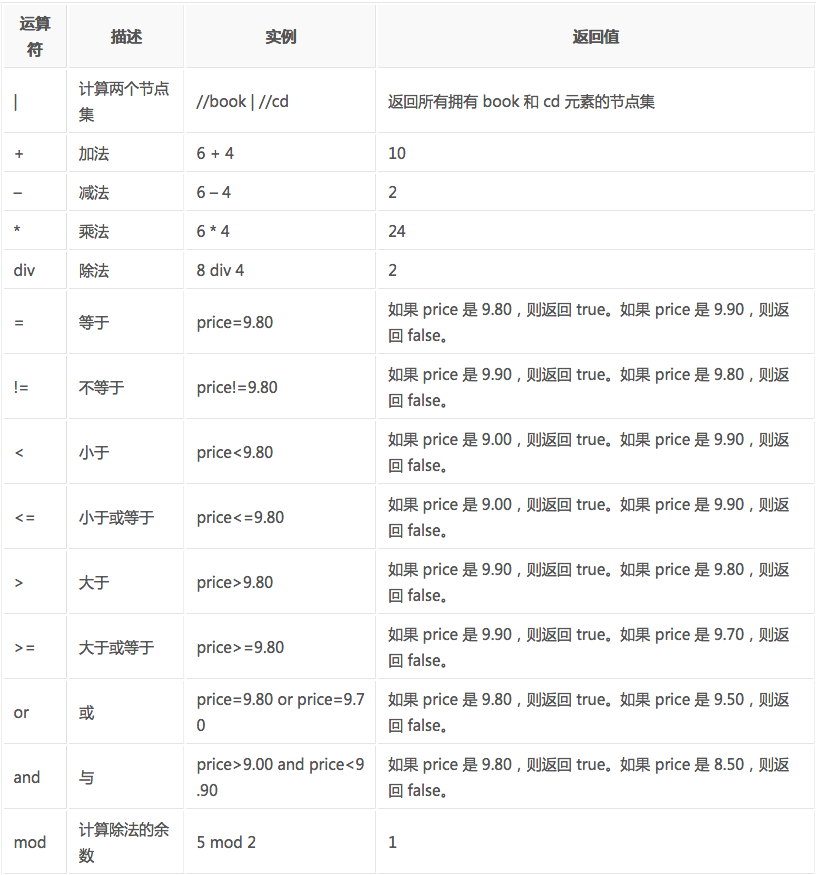一、XPath
XPath (XML Path Language) 是一门在 XML 文档中查找信息的语言,可用来在 XML 文档中对元素和属性进行遍历。
W3School官方文档:http://www.w3school.com.cn/xpath/index.asp
1.XPath 开发工具
- 开源的XPath表达式编辑工具:XMLQuire(XML格式文件可用)
- Chrome插件 XPath Helper
- Firefox插件 XPath Checker
Chrome中安装XPath 开发工具不能使用:
- 重启浏览器,快捷键CTRL+SHIFT+X开启XPath Helper插件;
- 长按CTRL+SHIFT,鼠标指向需提取的段落,按X开启或关闭提取,提取到的段落会变为黄色。
2.选取节点
XPath 使用路径表达式来选取 XML 文档中的节点或者节点集。这些路径表达式和我们在常规的电脑文件系统中看到的表达式非常相似。
下面列出了最常用的路径表达式:
| 表达式 | 描述 |
|---|---|
| nodename | 选取此节点的所有子节点。 |
| / | 从根节点选取。 |
| // | 从匹配选择的当前节点选择文档中的节点,而不考虑它们的位置。 |
| . | 选取当前节点。 |
| .. | 选取当前节点的父节点。 |
| @ | 选取属性。 |
在下面的表格中,我们已列出了一些路径表达式以及表达式的结果:
| 路径表达式 | 结果 |
|---|---|
| bookstore | 选取 bookstore 元素的所有子节点。 |
| /bookstore | 选取根元素 bookstore。注释:假如路径起始于正斜杠( / ),则此路径始终代表到某元素的绝对路径! |
| bookstore/book | 选取属于 bookstore 的子元素的所有 book 元素。 |
| //book | 选取所有 book 子元素,而不管它们在文档中的位置。 |
| bookstore//book | 选择属于 bookstore 元素的后代的所有 book 元素,而不管它们位于 bookstore 之下的什么位置。 |
| //@lang | 选取名为 lang 的所有属性。 |
3.谓语(Predicates)
谓语用来查找某个特定的节点或者包含某个指定的值的节点,被嵌在方括号中。
在下面的表格中,我们列出了带有谓语的一些路径表达式,以及表达式的结果:
| 路径表达式 | 结果 |
|---|---|
| /bookstore/book[1] | 选取属于 bookstore 子元素的第一个 book 元素。 |
| /bookstore/book[last()] | 选取属于 bookstore 子元素的最后一个 book 元素。 |
| /bookstore/book[last()-1] | 选取属于 bookstore 子元素的倒数第二个 book 元素。 |
| /bookstore/book[position()<3] | 选取最前面的两个属于 bookstore 元素的子元素的 book 元素。 |
| //title[@lang] | 选取所有拥有名为 lang 的属性的 title 元素。 |
| //title[@lang=’eng’] | 选取所有 title 元素,且这些元素拥有值为 eng 的 lang 属性。 |
| /bookstore/book[price>35.00] | 选取 bookstore 元素的所有 book 元素,且其中的 price 元素的值须大于 35.00。 |
| /bookstore/book[price>35.00]/title | 选取 bookstore 元素中的 book 元素的所有 title 元素,且其中的 price 元素的值须大于 35.00。 |
| //div[contains(@class,"f1")] | 选择div属性包含"f1"的元素 |
4.选取未知节点
XPath 通配符可用来选取未知的 XML 元素。
| 通配符 | 描述 |
|---|---|
| * | 匹配任何元素节点。 |
| @* | 匹配任何属性节点。 |
| node() | 匹配任何类型的节点。 |
在下面的表格中,我们列出了一些路径表达式,以及这些表达式的结果:
| 路径表达式 | 结果 |
|---|---|
| /bookstore/* | 选取 bookstore 元素的所有子元素。 |
| //* | 选取文档中的所有元素。 |
| html/node()/meta/@* | 选择html下面任意节点下的meta节点的所有属性 |
| //title[@*] | 选取所有带有属性的 title 元素。 |
5.选取若干路径
通过在路径表达式中使用“|”运算符,您可以选取若干个路径。
实例
在下面的表格中,我们列出了一些路径表达式,以及这些表达式的结果:
| 路径表达式 | 结果 |
|---|---|
| //book/title | //book/price | 选取 book 元素的所有 title 和 price 元素。 |
| //title | //price | 选取文档中的所有 title 和 price 元素。 |
| /bookstore/book/title | //price | 选取属于 bookstore 元素的 book 元素的所有 title 元素,以及文档中所有的 price 元素。 |
6.XPath的运算符
下面列出了可用在 XPath 表达式中的运算符:

 这些就是XPath的语法内容,在运用到Python抓取时要先转换为xml。
这些就是XPath的语法内容,在运用到Python抓取时要先转换为xml。
二、lxml库
lxml 是 一个HTML/XML的解析器,主要的功能是如何解析和提取 HTML/XML 数据。
lxml和正则一样,也是用 C 实现的,是一款高性能的 Python HTML/XML 解析器,我们可以利用之前学习的XPath语法,来快速的定位特定元素以及节点信息。
lxml python 官方文档:http://lxml.de/index.html
需要安装C语言库,可使用 pip 安装:
pip install lxml(或通过wheel方式安装)
1.lxml简单使用
.xpath() 返回值是一个列表,取值时需要注意
#encoding: utf-8
# 导入etree时需要手动,不会有提示
from lxml import etree
text = """
<table class="tablelist" cellpadding="0" cellspacing="0">
<tbody>
<tr class="h">
<td class="l" width="374">职位名称</td>
<td>职位类别</td>
<td>人数</td>
<td>地点</td>
<td>发布时间</td>
</tr>
<tr class="even">
<td class="l square"><a target="_blank" href="position_detail.php?id=33824&keywords=python&tid=87&lid=2218">22989-金融云区块链高级研发工程师(深圳)</a></td>
<td>技术类</td>
<td>1</td>
<td>深圳</td>
<td>2017-11-25</td>
</tr>
"""
# 从字符串中读取
def parse_text():
htmlElement = etree.HTML(text)
print(etree.tostring(htmlElement,encoding='utf-8').decode("utf-8"))
# 从文件中读取html代码
def parse_tencent_file():
htmlElement = etree.parse("tencent.html")
print(etree.tostring(htmlElement, encoding='utf-8').decode('utf-8'))
# 解析html,指定解析器,有时候html代码不规范需要指定解析器
def parse_lagou_file():
# 指定解析器
parser = etree.HTMLParser(encoding='utf-8')
htmlElement = etree.parse("lagou.html",parser=parser)
print(etree.tostring(htmlElement, encoding='utf-8').decode('utf-8'))
if __name__ == '__main__':
parse_text()
# parse_file()
# parse_lagou_file()
2.lxml和xpath结合使用
from lxml import etree
# 1. 获取所有tr标签
# 2. 获取第2个tr标签
# 3. 获取所有class等于even的tr标签
# 4. 获取所有a标签的href属性
# 5. 获取所有的职位信息(纯文本)
parser = etree.HTMLParser(encoding='utf-8')
html = etree.parse("tencent.html",parser=parser)
# 1. 获取所有tr标签
# //tr
# xpath函数返回的是一个列表
# trs = html.xpath("//tr")
# for tr in trs:
# print(etree.tostring(tr,encoding='utf-8').decode("utf-8"))
# 2. 获取第2个tr标签
# tr = html.xpath("//tr[2]")[0]
# print(etree.tostring(tr,encoding='utf-8').decode("utf-8"))
# 3. 获取所有class等于even的tr标签
# trs = html.xpath("//tr[@class='even']")
# for tr in trs:
# print(etree.tostring(tr,encoding='utf-8').decode("utf-8"))
# 4. 获取所有a标签的href属性
# aList = html.xpath("//a/@href")
# for a in aList:
# print("http://hr.tencent.com/"+a)
# 5. 获取所有的职位信息(纯文本)
trs = html.xpath("//tr[position()>1]")
positions = []
for tr in trs:
# 在某个标签下,再执行xpath函数,获取这个标签下的子孙元素
# 那么应该在//之前加一个点,代表是在当前元素下获取
href = tr.xpath(".//a/@href")[0]
fullurl = 'http://hr.tencent.com/' + href
title = tr.xpath("./td[1]//text()")[0]
category = tr.xpath("./td[2]/text()")[0]
nums = tr.xpath("./td[3]/text()")[0]
address = tr.xpath("./td[4]/text()")[0]
pubtime = tr.xpath("./td[5]/text()")[0]
position = {
'url': fullurl,
'title': title,
'category': category,
'nums': nums,
'address': address,
'pubtime': pubtime
}
positions.append(position)
print(positions)
3.lxml结合xpath注意事项
- 使用
xpath语法。应该使用Element.xpath方法。来执行xpath的选择。示例代码如下:
trs = html.xpath("//tr[position()>1]")
xpath函数,返回来的永远是一个列表。
- 获取某个标签的属性:
href = html.xpath("//a/@href") # 获取a标签的href属性对应的值
- 获取文本,是通过
xpath中的text()函数。示例代码如下:
address = tr.xpath("./td[4]/text()")[0]
- 在某个标签下,再执行
xpath函数,获取这个标签下的子孙元素,那么应该在斜杠之前加一个点,代表是在当前元素下获取。示例代码如下:
address = tr.xpath("./td[4]/text()")[0]
- xpath解析器下元素下标从1开始